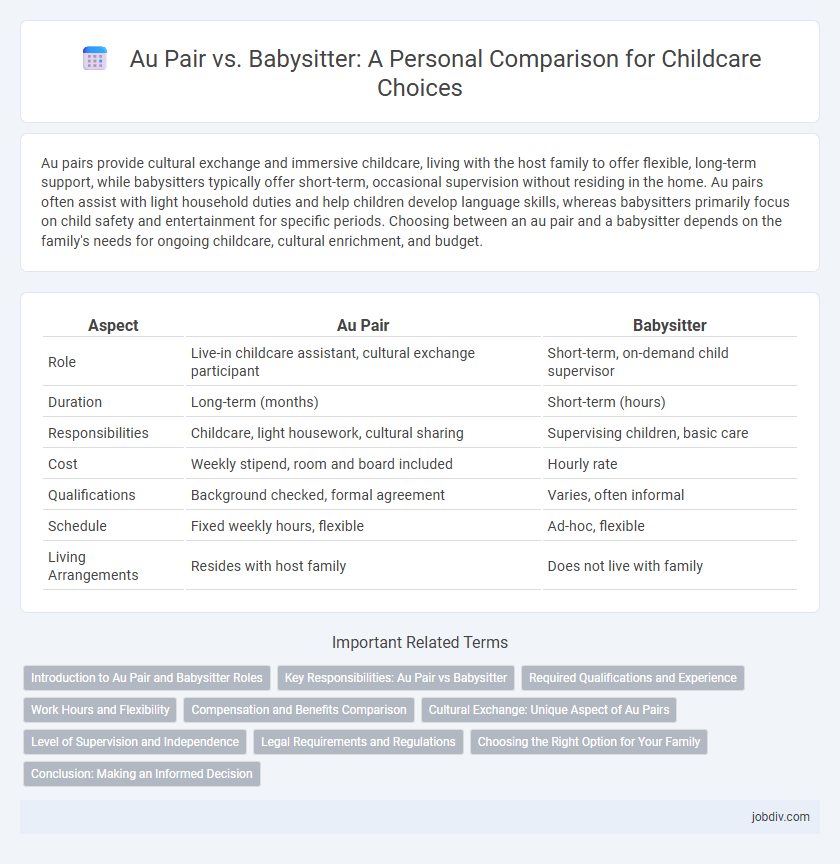Au pairs provide cultural exchange and immersive childcare, living with the host family to offer flexible, long-term support, while babysitters typically offer short-term, occasional supervision without residing in the home. Au pairs often assist with light household duties and help children develop language skills, whereas babysitters primarily focus on child safety and entertainment for specific periods. Choosing between an au pair and a babysitter depends on the family's needs for ongoing childcare, cultural enrichment, and budget.
Table of Comparison
| Aspect | Au Pair | Babysitter |
|---|---|---|
| Role | Live-in childcare assistant, cultural exchange participant | Short-term, on-demand child supervisor |
| Duration | Long-term (months) | Short-term (hours) |
| Responsibilities | Childcare, light housework, cultural sharing | Supervising children, basic care |
| Cost | Weekly stipend, room and board included | Hourly rate |
| Qualifications | Background checked, formal agreement | Varies, often informal |
| Schedule | Fixed weekly hours, flexible | Ad-hoc, flexible |
| Living Arrangements | Resides with host family | Does not live with family |
Introduction to Au Pair and Babysitter Roles
An au pair lives with a host family to provide childcare while immersing in a new culture, often engaging in light household duties and language exchange. A babysitter offers occasional, short-term childcare services, focusing primarily on supervising and entertaining children during specific periods. Both roles support families but differ in commitment, cultural exchange, and scope of responsibilities.
Key Responsibilities: Au Pair vs Babysitter
Au pairs typically live with the host family and provide childcare alongside light household duties such as meal preparation and tidying up children's play areas, fostering cultural exchange and daily interaction. Babysitters generally offer short-term, flexible childcare focused solely on supervising children during parents' absence, without involvement in household tasks. Au pairs often engage in educational activities and routine care, while babysitters provide temporary supervision and ensure children's safety during limited hours.
Required Qualifications and Experience
Au pairs typically need to be between 18 and 30 years old, with basic childcare experience and a background in language or cultural exchange programs. Babysitters often require experience in childcare, but formal qualifications like CPR and first aid certification are highly recommended for safety. Au pairs usually live with the host family and provide more immersive care, while babysitters work on a flexible, part-time basis without mandatory cultural exchange criteria.
Work Hours and Flexibility
Au pairs typically work 25 to 30 hours per week with flexible scheduling designed to accommodate cultural exchange and personal time, whereas babysitters often have more variable hours based on immediate family needs, ranging from occasional evenings to full days. Au pairs live with the host family, offering consistent availability and integrated childcare support, while babysitters usually work on a part-time or as-needed basis without residency requirements. Flexibility for au pairs includes time off for language classes and social activities, contrasting with babysitters' on-demand flexibility tied directly to scheduled childcare sessions.
Compensation and Benefits Comparison
Au pairs typically receive a weekly stipend ranging from $195 to $250 plus free room and board, whereas babysitters charge hourly rates averaging $15 to $25 without additional benefits. Au pairs often gain cultural exchange experiences and language immersion, while babysitters generally do not have formal agreements involving personal development opportunities. Families employing au pairs may benefit from more flexible scheduling and longer-term commitments compared to the casual arrangements common with babysitters.
Cultural Exchange: Unique Aspect of Au Pairs
Au pairs offer a distinct cultural exchange experience by living with the host family, sharing daily routines, and immersing themselves in the language and customs of the country. This arrangement fosters mutual understanding and personal growth for both the au pair and the family, beyond typical childcare duties. Babysitters, in contrast, provide childcare services without the cultural integration element, focusing solely on supervision and care during specific hours.
Level of Supervision and Independence
Au pairs typically provide a higher level of supervision combined with greater independence, as they live with the host family and integrate into daily routines, offering consistent care and cultural exchange. Babysitters usually offer intermittent, task-specific supervision, often during evenings or weekends, with limited responsibility beyond basic childcare tasks. The au pair's immersive role allows for ongoing guidance and involvement, whereas babysitters operate more independently within shorter, defined time frames.
Legal Requirements and Regulations
Au pairs must comply with specific legal requirements including visa regulations, work hour limitations, and formal agreements often mandated by host countries, ensuring their stay is both lawful and structured. Babysitters typically face fewer legal stipulations, with regulations varying widely by locality, often depending on age, background checks, and duration of care. Understanding these distinctions is crucial for families to meet legal obligations while choosing appropriate child care.
Choosing the Right Option for Your Family
Selecting between an au pair and a babysitter depends on your family's specific needs and lifestyle. Au pairs typically offer cultural exchange benefits and live with the family, providing flexible hours and light household duties, while babysitters usually work on a part-time basis for occasional childcare. Assessing factors like schedule consistency, desired level of involvement, and budget helps determine the best fit for your family.
Conclusion: Making an Informed Decision
Choosing between an au pair and a babysitter depends on the family's specific needs, budget, and desired level of cultural exchange or language immersion. Au pairs provide long-term childcare combined with cultural experiences, often living with the family, while babysitters offer flexible, short-term assistance focused solely on child supervision. Evaluating factors such as cost, commitment, and personal interaction helps ensure an informed decision that aligns with family dynamics and childcare goals.
Au Pair vs Babysitter Infographic

 jobdiv.com
jobdiv.com